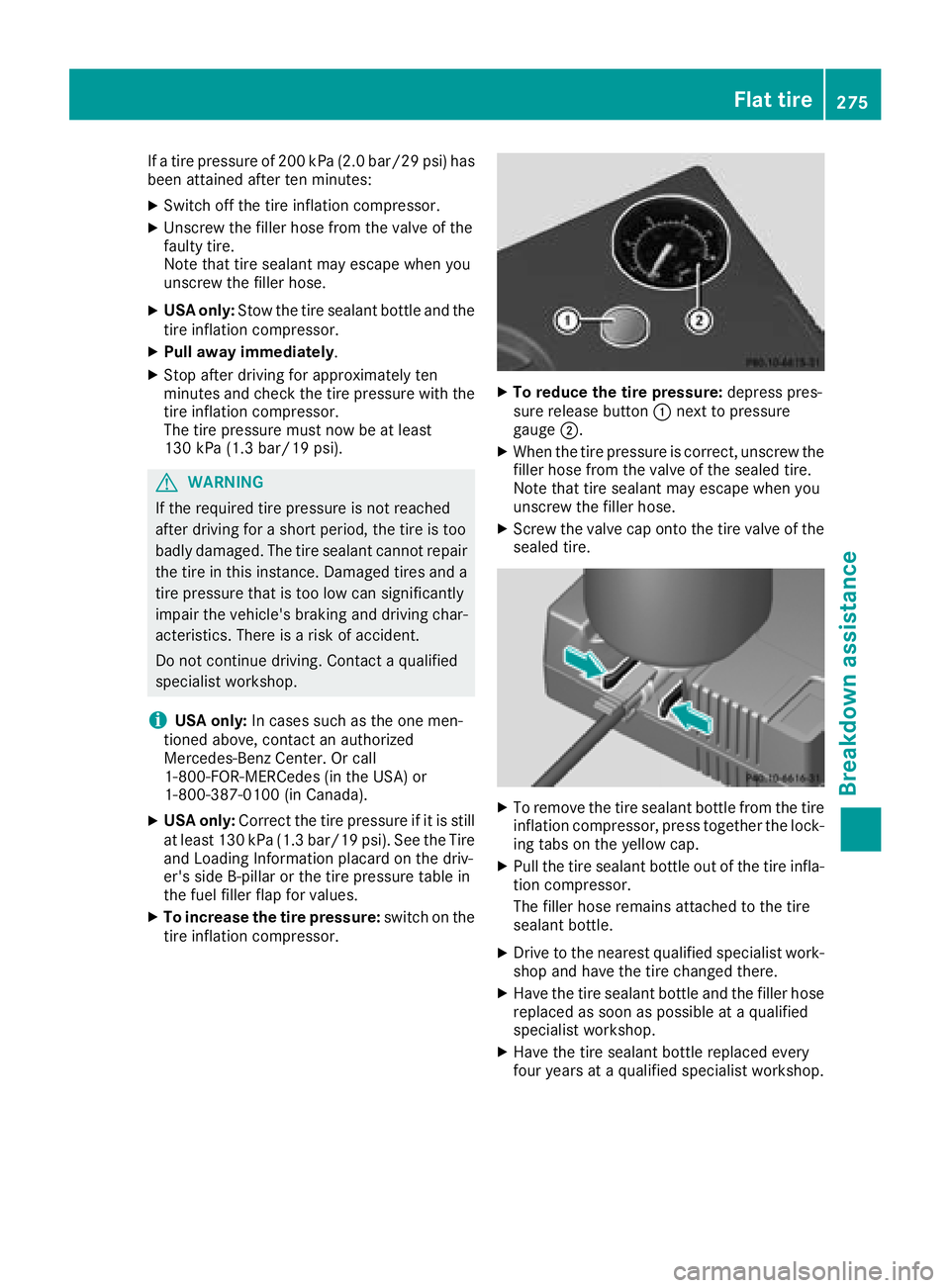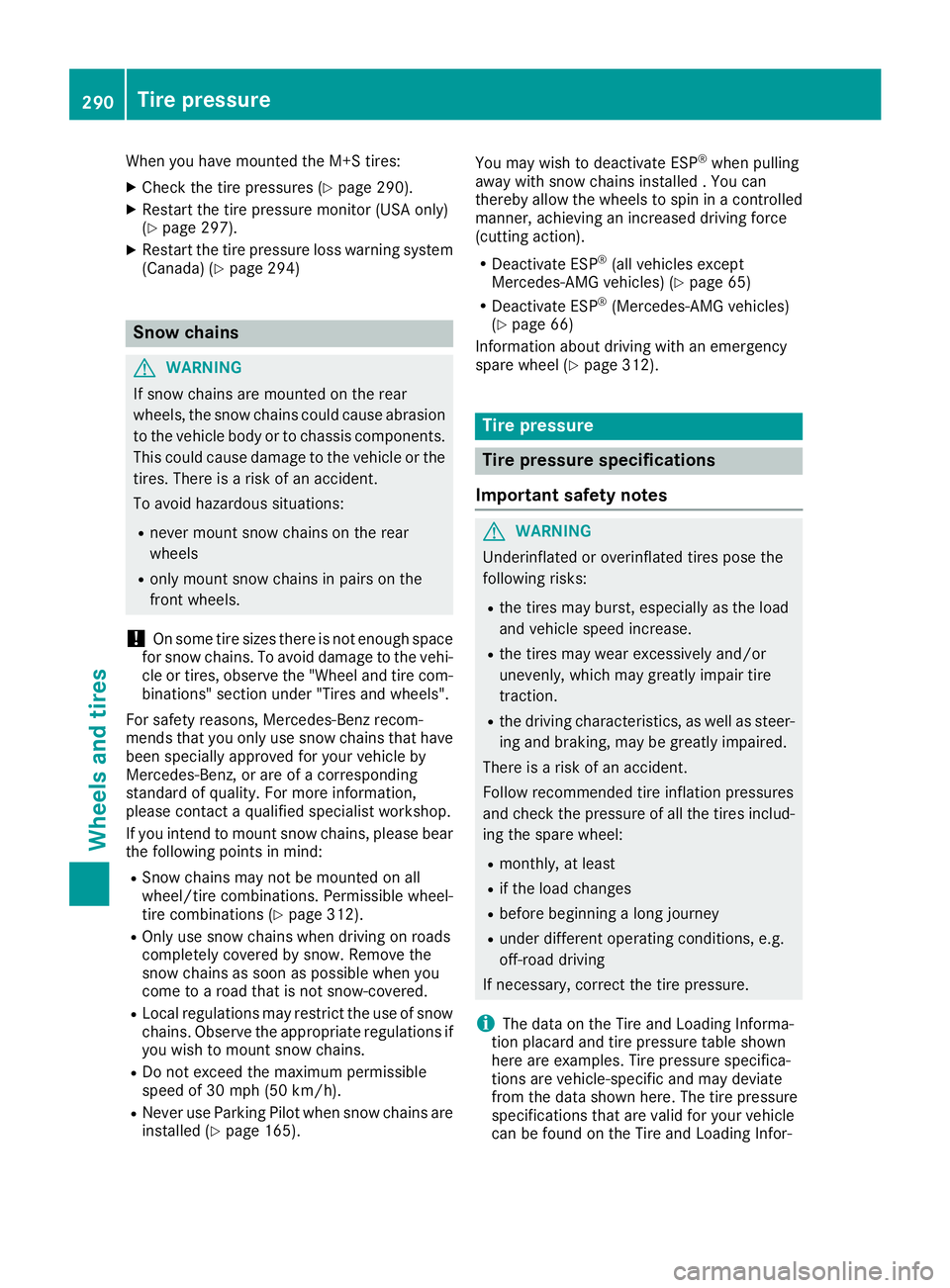inflation pressure MERCEDES-BENZ CLA 2018 Owners Manual
[x] Cancel search | Manufacturer: MERCEDES-BENZ, Model Year: 2018, Model line: CLA, Model: MERCEDES-BENZ CLA 2018Pages: 326, PDF Size: 7.97 MB
Page 277 of 326

If at ire pressure of 200 kPa (2.0 bar/29 psi) has
been attained after ten minutes: X
Switch off the tire inflation compressor. X
Unscrew the fille rh ose from the valve of the
faulty tire.
Note that tire sealant may escape when you
unscrew the fille rh ose.X
USA only: Stow the tire sealant bottle and the
tire inflation compressor. X
Pull away immediately .X
Stop after driving for approximately ten
minutes and check the tire pressure with the
tire inflation compressor.
The tire pressure must now be at least
130 kPa (1.3 bar/19 psi).
G WARNING
If the required tire pressure is not reached
after driving for as hort period ,t he tire is too
badl yd amaged. The tire sealant cannot repair
the tire in this instance. Damaged tires and a
tire pressure that is too low can significantly
impair the vehicle's braking and driving char-
acteristics. There is ar isk of accident.
Do not continue driving. Contact aq ualified
specialist workshop.
i USA only: In cases such as the one men-
tioned above ,c ontact an authorized
Mercedes-Benz Center. Or call
1-800-FOR-MERCedes (in the USA) or
1-800-387-0100 (in Canada). X
USA only: Correct the tire pressure if it is still
at least 130 kPa (1.3 bar/19 psi). See the Tire
and Loading Information placard on the driv-
er's side B-pilla rort he tire pressure table in
the fuel fille rf lap for values.X
To increase the tire pressure: switch on the
tire inflation compressor. X
To reduce the tire pressure: depres sp res-
sure release button �C next to pressure
gauge �D . X
When the tire pressure is correct, unscrew the
fille rh ose from the valve of the sealed tire.
Note that tire sealant may escape when you
unscrew the fille rh ose.X
Screw the valve cap onto the tire valve of the
sealed tire.
X
To remove the tire sealant bottle from the tire
inflation compressor, press together the lock-
ing tabs on the yellow cap. X
Pul lt he tire sealant bottle out of the tire infla-
tion compressor.
The fille rh ose remains attached to the tire
sealant bottle. X
Drive to the nearest qualifie ds pecialist work-
shop and have the tire changed there. X
Have the tire sealant bottle and the fille rh ose
replaced as soon as possible at aq ualified
specialist workshop. X
Have the tire sealant bottle replaced every
four years at aq ualifie ds pecialist workshop.Flat tire 275
Breakdow na ssistance Z
Page 292 of 326

When you have mounted the M+S tires: X
Check the tire pressures ( Y
page 290).X
Restart the tire pressure monitor (USA only)
( Y
page 297).X
Restart the tire pressure loss warning system
(Canada) ( Y
page 294)
Snow chains
G WARNING
If snow chains are mounted on the rear
wheels, the snow chains could cause abrasion
to the vehicle body or to chassis components.
This could cause damage to the vehicle or the
tires. There is ar isk of an accident.
To avoid hazardous situations: R
never mount snow chains on the rear
wheels R
only mount snow chains in pairs on the
fron tw heels.
! On some tire sizes there is not enough space
for snow chains. To avoid damage to the vehi-
cle or tires, observe the "Wheel and tire com-
binations" section under "Tires and wheels".
For safety reasons, Mercedes-Benz recom-
mends that you only use snow chains that have
been specially approved for your vehicle by
Mercedes-Benz ,ora re of ac orresponding
standard of quality. For more information,
please contact aq ualified specialist workshop.
If you inten dtom ount snow chains, please bear
the following points in mind: R
Sno wc hains may not be mounted on all
wheel/tire combinations. Permissible wheel-
tire combinations ( Y
page 312).R
Only use snow chains when driving on roads
completely covered by snow. Remove the
snow chains as soon as possible when you
come to ar oad that is not snow-covered.R
Local regulations may restrict the use of snow
chains. Observe the appropriate regulations if
you wish to mount snow chains. R
Do not exceed the maximum permissible
speed of 30 mph (50 km/h). R
Never use Parking Pilot when snow chains are
installed ( Y
page 165). You may wish to deactivat eE SP ®
when pulling
away with snow chains installed .Y ou can
thereby allow the wheels to spin in ac ontrolled
manner, achieving an increased driving force
(cutting action). R
Deactivate ESP ®
(all vehicles except
Mercedes-AMG vehicles) ( Y
page 65)R
Deactivate ESP ®
(Mercedes-AMG vehicles)
( Y
page 66)
Information about driving with an emergency
spare wheel ( Y
page 312).
Tir ep re ssure
Tir ep re ssure specifications
Important safety notes
G WARNING
Underinflated or overinflated tires pose the
following risks: R
the tires may burst, especially as the load
and vehicle speed increase. R
the tires may wear excessively and/or
unevenly, which may greatly impair tire
traction. R
the driving characteristics, as well as steer-
ing and braking, may be greatly impaired.
There is ar isk of an accident.
Follow recommended tire inflation pressures
and check the pressure of all the tires includ-
ing the spare wheel: R
monthly, at least R
if the load changes R
before beginnin gal ong journeyR
under differen to perating conditions, e.g.
off-road driving
If necessary, correct the tire pressure.
i The data on the Tire and Loading Informa-
tion placard and tire pressure table shown
here are examples. Tire pressure specifica-
tions are vehicle-specific and may deviate
from the data shown here. The tire pressure
specifications that are valid for your vehicle
can be found on the Tire and Loading Infor-290
Tir ep re ssure
Wheels and tires
Page 297 of 326

shown in the Serv. menu of the multifunction
display, see illustration (example).
For information on the message display, refer to
the "Checking the tire pressure electronically"
section ( Y
page 296).
Important safety notes
G WARNING
Each tire, including the spare (if provided),
should be checked at least once every two
weeks when cold and inflated to the pressure
recommended by the vehicle manufacturer
on the Tire and Loading Information placard
on the driver's door B-pillar or the tire pres-
sure label on the inside of the fuel filler flap. If
your vehicle has tires of ad ifferent size than
the size indicated on the Tire and Loading
Information placard or, if available, the tire
pressure label ,y ou should determine the
proper tire pressure for those tires.
As an added safety feature, your vehicle has
been equipped with at ire pressure monitoring
system (TPMS) that illuminates al ow tire pres-
sure telltale when one or more of your tires
are significantly underinflated. Accordingly,
when the low tire pressure telltale lights up,
you should stop and check your tires as soon
as possible ,a nd inflate them to the proper
pressure. Driving on as ignificantly underin-
flated tire causes the tire to overheat and can
lead to tire failure.
Underinflation also reduces fuel efficiency
and tire tread life, and may affect the vehicle's
handling and stopping ability. Please note that
the TPMS is not as ubstitute for proper tire
maintenance, and it is the driver's responsi-
bility to maintain correct tire pressure, even if
underinflation has not reached the level to trigger illumination of the TPMS low tire pres-
sure telltale.
Your vehicle has also been equipped with a
TPMS malfunction indicator to indicate when
the system is not operating properly. The
TPMS malfunction indicator is combined with
the low tire pressure telltale. When the sys-
tem detects am alfunction, the warning lamp
will flash for approximately am inute and then
remain continuously illuminated. This
sequence will be repeated every time the vehi-
cle is started as long as the malfunction
exists. When the malfunction indicator is illu-
minated, the system may not be able to detect
or signal low tire pressure as intended.
TPMS malfunctions may occur for av ariety of
reasons, including the installation of incom-
patible replacement or alternate tires or
wheels on the vehicle that prevent the TPMS
from functionin gp roperly. Always check the
TPMS malfunction telltale after replacing one
or more tires or wheels on your vehicle to
ensure that the replacement or alternate Tires
and wheels allow the TPMS to continue to
function properly.
It is the driver's responsibility to set the tire
pressure to that recommended for cold tires
which is suitable for the operating situation
( Y
page 290). Note that the correct tire pressure
for the current operating situation must first be
taught-in to the tire pressure monitor. If as ub-
stantial loss of pressure occurs, the warning
threshold for the warning message is aligned to
the taught-in reference values. Restart the tire
pressure monitor after adjusting the pressure of
the cold tires ( Y
page 297). The current pres-
sures are saved as new reference values. As a
result, aw arning message will appea rift he tire
pressure drops significantly.
The tire pressure monitor does not warn you of
an incorrectly set tire pressure. Observe the
notes on the recommended tire pressure
( Y
page 290).
The tire pressure monitor is not able to warn you
of as udden loss of pressure, e.g. if the tire is
penetrated by af oreign object. In the event of a
sudden loss of pressure, bring the vehicle to a
halt by braking carefully .A void abrupt steering
movements. Tire pressure 295
Wheels and tires Z